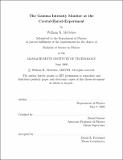The Gamma Intensity Monitor at the Crystal-Barrel-Experiment
Author(s)
McGehee, William R
DownloadFull printable version (4.829Mb)
Other Contributors
Massachusetts Institute of Technology. Dept. of Physics.
Advisor
Bernd Surrow.
Terms of use
Metadata
Show full item recordAbstract
This thesis details the motivation, design, construction, and testing of the Gamma Intensity Monitor (GIM) for the Crystal-Barrel-Experiment at the Universität Bonn. The CB-ELSA collaboration studies the baryon excitation spectrum; resonances are produced by exciting nucleons in a polarized target with a linearly or circularly polarized, GeV-order photon beam. The photoproduced decay states are measured by a variety of detectors covering almost 4[pi] of the solid angle about the target. To measure the total cross section of these reactions, the total flux of photons through the target must be known to high accuracy. As the total cross section for nuclear photoproduction is low, counting the photons unscattered in the target is sufficiently accurate measurement of this quantity{this is the purpose of the Gamma Intensity Monitor. It is the final detector along the beam path and counts all photons that do not react with the target. The major design parameter is that the detector must consistently count GeV order photons at 10 MHz. This is accomplished by allowing the gammas to electronpositron pair produce within Ĉerenkov radiating PbF2 crystals. The Cerenkov light from these highly relativistic lepton pairs is measured with industrial photomultiplier tubes to provide an effective efficiency close to unity. Special bases were built for photomultiplier to ensure stable signal amplication even high count rates. Detailed descriptions of the GIM are provided to ensure that its inner working are completely transparent and to enable efficient operation and maintenance of the detector.
Description
Thesis (S.B.)--Massachusetts Institute of Technology, Dept. of Physics, 2008. This electronic version was submitted by the student author. The certified thesis is available in the Institute Archives and Special Collections. Includes bibliographical references (p. 69).
Date issued
2008Department
Massachusetts Institute of Technology. Department of PhysicsPublisher
Massachusetts Institute of Technology
Keywords
Physics.